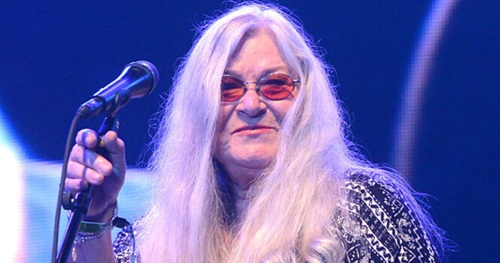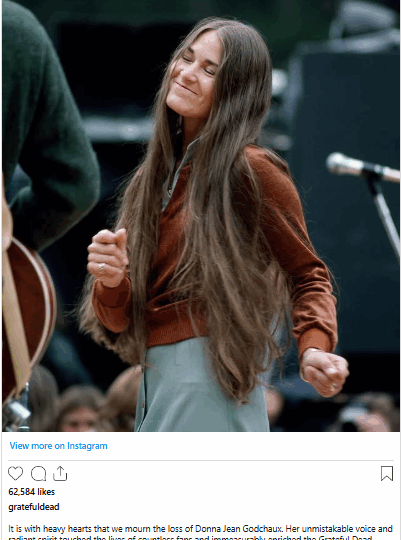
The music world is in mourning following the death of Donna Jean Godchaux-MacKay, the talented singer who lent her voice to Elvis Presley’s iconic hit Suspicious Minds and became the only woman to ever hold a permanent position in the legendary rock band, the Grateful Dead
. She passed away at Alive Hospice in Nashville at the age of 78 after a long battle with cancer, leaving behind a legacy that touched generations of fans. Her family confirmed her passing in a statement, describing her as “a sweet and warmly beautiful spirit, and all who knew her feel this loss deeply,” and requested privacy during this difficult time.
They concluded their message with words from Grateful Dead lyricist Robert Hunter: “May the four winds blow her safely home.”
Born Donna Jean Thatcher in Florence, Alabama, Godchaux-MacKay was immersed in music from a very young age.
At just 12 years old, she began spending time at the legendary Muscle Shoals Sound Studio, a site where some of the most influential recordings in American music history were made.
There, she witnessed Aretha Franklin, Otis Redding, and countless other legends creating music that would define the era. These experiences had a profound effect on her, shaping both her musical ear and her aspirations.
Her early career as a session singer quickly took off. She contributed to iconic songs like Percy Sledge’s When a Man Loves a Woman, demonstrating a remarkable ability to blend her voice seamlessly with established stars.
Her most famous session, however, would come in 1969 when she recorded backup vocals for Elvis Presley on Suspicious Minds, a song that would become one of the most celebrated tracks of his career.

The Elvis Presley Connection
The story of how Godchaux-MacKay came to work with Elvis is often described as a fairy tale.
At the time, her music group had recorded a demo of Suspicious Minds, written by her friend Mark James, at Memphis’ American Sound Studios.
According to accounts, Elvis happened to walk past an office where the demo was playing. Captivated, he stopped and reportedly exclaimed, “I want that song. And I want those girls.”
Donna Jean later recalled in a 2008 interview with the Star Tribune, “When we got the call, we screamed bloody murder.” Working with Presley was a transformative experience.
She described him as “trim, gorgeous, and the most beautiful creature I’d ever seen in my life.” Over the course of the sessions, they also recorded In the Ghetto and other tracks.
She recalled that Presley was “kind, sweet, and encouraging,” making the experience unforgettable.
After the sessions, she and fellow backup singer Jeannie Green celebrated with two hours of screaming at a local International House of Pancakes, a moment that has since become legendary in rock ’n’ roll lore.
Her time with Elvis opened doors to collaborations with other music icons, including Cher, Boz Scaggs, Neil Diamond, and Duane Allman.
Her versatility as a session singer and her ability to elevate any track she touched cemented her reputation as a uniquely gifted vocalist.
Joining the Grateful Dead
In 1970, Donna Jean married pianist Keith Godchaux, and two years later, both joined the Grateful Dead.
From 1972 to 1979, she contributed her gospel-infused harmonies and occasional lead vocals to the band’s albums, including Europe ’72, Wake of the Flood, and Shakedown Street.
Fans fondly remember her powerful performances on songs like Sunrise, You Ain’t Woman Enough, and Tomorrow Is Forever.
Donna Jean’s background in meticulously arranged music initially contrasted sharply with the improvisational, free-flowing style of the Dead. She later reflected on her first experience with the band:
“It just blew everything I ever thought out of the water. I couldn’t believe the lyrics, the chord structures, how the harmonies blended.” Inspired, she sought out guitarist Jerry Garcia, encouraging him to hire her husband Keith as the band’s pianist.
Within weeks, both Keith and Donna Jean were members of the Grateful Dead, marking a pivotal era in the band’s evolution.
While some Deadheads debated her style, her contributions helped shape the band’s sound during a period of experimentation and transformation.
She brought a distinctive gospel and R&B influence to the group, enriching its musical palette and leaving a lasting impression on the Grateful Dead’s recordings and live performances.

Tragedy and Later Career
After leaving the Grateful Dead in 1979, Donna Jean and Keith formed the Heart of Gold Band, which had a brief but noteworthy run. Tragedy struck in 1980 when Keith died in a car accident, leaving Donna Jean widowed and grieving.
She eventually returned to Muscle Shoals, marrying bassist David MacKay, and continued her career in music.
In 1998, she formed the Donna Jean Band, later creating Donna Jean and the Tricksters. Her last album, released in 2014 in collaboration with Jeff Mattson of the Zen Tricksters, showcased her continued vitality and creative spirit.
Over decades, her music remained beloved, drawing in new fans while holding a special place in the hearts of longtime admirers.
Legacy and Tributes
The Grateful Dead officially confirmed her passing via Instagram, writing: “It is with heavy hearts that we mourn the loss of Donna Jean Godchaux.
Her unmistakable voice and radiant spirit touched countless fans and enriched the Grateful Dead family. Her contributions will forever remain part of the tapestry we continue to weave.”
Donna Jean Godchaux-MacKay is survived by her husband, David MacKay, her sons Zion “Rock” Godchaux and Kinsman MacKay (and his wife Molly), her grandson Delta, her sister Gogi Clark, and her brother Ivan Thatcher.
Her life and career, spanning decades and countless musical milestones, left an indelible mark on both the world of rock music and American popular culture.
From Muscle Shoals to the stages of the Grateful Dead, and from recording studios with Elvis Presley to her own bands, her voice and spirit will be remembered and cherished by generations to come.
Her story is a testament to talent, resilience, and passion for music—a story that will continue to inspire aspiring musicians and fans around the world.
Donna Jean Godchaux-MacKay’s legacy is not just in the songs she sang, but in the hearts of those she touched, the trails she blazed for women in rock, and the joy her music continues to bring.
The music world is in mourning following the death of Donna Jean Godchaux-MacKay, the talented singer who lent her voice to Elvis Presley’s iconic hit Suspicious Minds and became the only woman to ever hold a permanent position in the legendary rock band, the Grateful Dead
. She passed away at Alive Hospice in Nashville at the age of 78 after a long battle with cancer, leaving behind a legacy that touched generations of fans. Her family confirmed her passing in a statement, describing her as “a sweet and warmly beautiful spirit, and all who knew her feel this loss deeply,” and requested privacy during this difficult time.
They concluded their message with words from Grateful Dead lyricist Robert Hunter: “May the four winds blow her safely home.”
Born Donna Jean Thatcher in Florence, Alabama, Godchaux-MacKay was immersed in music from a very young age.
At just 12 years old, she began spending time at the legendary Muscle Shoals Sound Studio, a site where some of the most influential recordings in American music history were made.
There, she witnessed Aretha Franklin, Otis Redding, and countless other legends creating music that would define the era. These experiences had a profound effect on her, shaping both her musical ear and her aspirations.
Her early career as a session singer quickly took off. She contributed to iconic songs like Percy Sledge’s When a Man Loves a Woman, demonstrating a remarkable ability to blend her voice seamlessly with established stars.
Her most famous session, however, would come in 1969 when she recorded backup vocals for Elvis Presley on Suspicious Minds, a song that would become one of the most celebrated tracks of his career.

The Elvis Presley Connection
The story of how Godchaux-MacKay came to work with Elvis is often described as a fairy tale.
At the time, her music group had recorded a demo of Suspicious Minds, written by her friend Mark James, at Memphis’ American Sound Studios.
According to accounts, Elvis happened to walk past an office where the demo was playing. Captivated, he stopped and reportedly exclaimed, “I want that song. And I want those girls.”
Donna Jean later recalled in a 2008 interview with the Star Tribune, “When we got the call, we screamed bloody murder.” Working with Presley was a transformative experience.
She described him as “trim, gorgeous, and the most beautiful creature I’d ever seen in my life.” Over the course of the sessions, they also recorded In the Ghetto and other tracks.
She recalled that Presley was “kind, sweet, and encouraging,” making the experience unforgettable.
After the sessions, she and fellow backup singer Jeannie Green celebrated with two hours of screaming at a local International House of Pancakes, a moment that has since become legendary in rock ’n’ roll lore.
Her time with Elvis opened doors to collaborations with other music icons, including Cher, Boz Scaggs, Neil Diamond, and Duane Allman.
Her versatility as a session singer and her ability to elevate any track she touched cemented her reputation as a uniquely gifted vocalist.
Joining the Grateful Dead
In 1970, Donna Jean married pianist Keith Godchaux, and two years later, both joined the Grateful Dead.
From 1972 to 1979, she contributed her gospel-infused harmonies and occasional lead vocals to the band’s albums, including Europe ’72, Wake of the Flood, and Shakedown Street.
Fans fondly remember her powerful performances on songs like Sunrise, You Ain’t Woman Enough, and Tomorrow Is Forever.
Donna Jean’s background in meticulously arranged music initially contrasted sharply with the improvisational, free-flowing style of the Dead. She later reflected on her first experience with the band:
“It just blew everything I ever thought out of the water. I couldn’t believe the lyrics, the chord structures, how the harmonies blended.” Inspired, she sought out guitarist Jerry Garcia, encouraging him to hire her husband Keith as the band’s pianist.
Within weeks, both Keith and Donna Jean were members of the Grateful Dead, marking a pivotal era in the band’s evolution.
While some Deadheads debated her style, her contributions helped shape the band’s sound during a period of experimentation and transformation.
She brought a distinctive gospel and R&B influence to the group, enriching its musical palette and leaving a lasting impression on the Grateful Dead’s recordings and live performances.

Tragedy and Later Career
After leaving the Grateful Dead in 1979, Donna Jean and Keith formed the Heart of Gold Band, which had a brief but noteworthy run. Tragedy struck in 1980 when Keith died in a car accident, leaving Donna Jean widowed and grieving.
She eventually returned to Muscle Shoals, marrying bassist David MacKay, and continued her career in music.
In 1998, she formed the Donna Jean Band, later creating Donna Jean and the Tricksters. Her last album, released in 2014 in collaboration with Jeff Mattson of the Zen Tricksters, showcased her continued vitality and creative spirit.
Over decades, her music remained beloved, drawing in new fans while holding a special place in the hearts of longtime admirers.
Legacy and Tributes
The Grateful Dead officially confirmed her passing via Instagram, writing: “It is with heavy hearts that we mourn the loss of Donna Jean Godchaux.
Her unmistakable voice and radiant spirit touched countless fans and enriched the Grateful Dead family. Her contributions will forever remain part of the tapestry we continue to weave.”
Donna Jean Godchaux-MacKay is survived by her husband, David MacKay, her sons Zion “Rock” Godchaux and Kinsman MacKay (and his wife Molly), her grandson Delta, her sister Gogi Clark, and her brother Ivan Thatcher.
Her life and career, spanning decades and countless musical milestones, left an indelible mark on both the world of rock music and American popular culture.
From Muscle Shoals to the stages of the Grateful Dead, and from recording studios with Elvis Presley to her own bands, her voice and spirit will be remembered and cherished by generations to come.
Her story is a testament to talent, resilience, and passion for music—a story that will continue to inspire aspiring musicians and fans around the world.
Donna Jean Godchaux-MacKay’s legacy is not just in the songs she sang, but in the hearts of those she touched, the trails she blazed for women in rock, and the joy her music continues to bring.